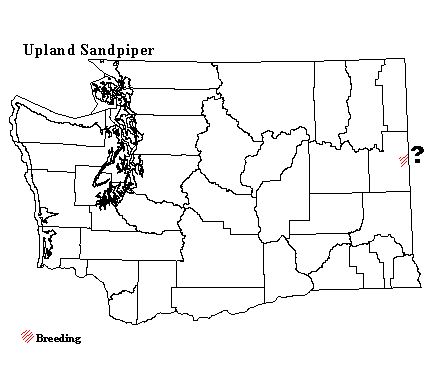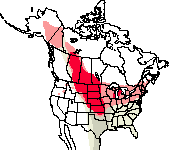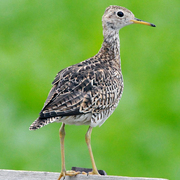Upland Sandpiper
General Description
The Upland Sandpiper is a black, brown, and white mottled bird with a long neck and tail and yellow legs. It has a round head with large, black eyes, and a relatively short bill for a sandpiper. In flight, it shows a pale inner wing, dark outer wing, and white outer primary shaft.
Habitat
Native grassland is the Upland Sandpiper's preferred habitat. It typically feeds in shortgrass areas, where it is found in migration and during winter. The Upland Sandpiper requires taller grass for nesting. It is almost never found on mudflats or in wetland environments where other shorebirds are found. These birds are common nesters at airfields and airports throughout their range.
Behavior
During the breeding season, Upland Sandpipers often perch on fence posts or utility poles. They forage by walking quickly through the grass with jerky movements, picking up items from the ground or from low vegetation.
Diet
Upland Sandpipers eat mostly insects, but also feed on waste grains and other seeds.
Nesting
Upland Sandpipers may nest in loose colonies, in which case the colony has a highly synchronous nesting pattern, meaning that all the chicks hatch at the same time. Nests are shallow scrapes on the ground in dense grass. They are often well hidden from above with grass arching over the top. Both parents help build the nest and incubate the 4 eggs for 22 to 27 days. The young leave the nest shortly after hatching and, while the young feed themselves, the parents protect and tend them. The young first fly at 30 to 31 days.
Migration Status
Upland Sandpipers are long-distance migrants, spending the winter in the pampas of southern South America. Migration is typically through the Great Plains, but is more spread out in the fall with juveniles reaching to the coasts. Fall migration begins in mid-July and usually lasts through September. Spring migration is from March through May.
Conservation Status
The Canadian Wildlife Service estimates the Upland Sandpiper population at about 350,000 birds. Most of the population is concentrated in the Great Plains, where they are still common. In both the northeastern and northwestern portion of their range, Upland Sandpipers have become far less common. Although they were probably never abundant in the Northwest, they formerly bred widely in eastern Washington. With the loss of native grassland habitat, the Northwest population has now dwindled to a few small, isolated populations. The last remaining Washington population, near Spokane, is most likely extirpated. With the Spokane population gone, a small population in Idaho, another group in Montana, and a few dozen pairs in Oregon are the only breeding Upland Sandpipers that remain in the Northwest. The Upland Sandpiper is still listed as a state endangered species and a Gap Analysis species-at-risk.
When and Where to Find in Washington
The last confirmed records of breeding Upland Sandpipers in Washington were in 1993, from the population in the Newman Lake area between Spokane (Spokane County) and the Idaho border. Migrants are recorded about once a year in the Pacific Northwest. They are occasional in the spring in May, but are more often seen in the fall, in August throughout eastern Washington, and from late August to September along the coast. In the fall, most birds are juveniles, probably from the Alaska/Yukon breeding population.
Washington Range Map

North American Range Map


Family Members
 Spotted SandpiperActitis macularius
Spotted SandpiperActitis macularius Solitary SandpiperTringa solitaria
Solitary SandpiperTringa solitaria Gray-tailed TattlerTringa brevipes
Gray-tailed TattlerTringa brevipes Wandering TattlerTringa incana
Wandering TattlerTringa incana Greater YellowlegsTringa melanoleuca
Greater YellowlegsTringa melanoleuca WilletTringa semipalmata
WilletTringa semipalmata Lesser YellowlegsTringa flavipes
Lesser YellowlegsTringa flavipes Upland SandpiperBartramia longicauda
Upland SandpiperBartramia longicauda Little CurlewNumenius minutus
Little CurlewNumenius minutus WhimbrelNumenius phaeopus
WhimbrelNumenius phaeopus Bristle-thighed CurlewNumenius tahitiensis
Bristle-thighed CurlewNumenius tahitiensis Long-billed CurlewNumenius americanus
Long-billed CurlewNumenius americanus Hudsonian GodwitLimosa haemastica
Hudsonian GodwitLimosa haemastica Bar-tailed GodwitLimosa lapponica
Bar-tailed GodwitLimosa lapponica Marbled GodwitLimosa fedoa
Marbled GodwitLimosa fedoa Ruddy TurnstoneArenaria interpres
Ruddy TurnstoneArenaria interpres Black TurnstoneArenaria melanocephala
Black TurnstoneArenaria melanocephala SurfbirdAphriza virgata
SurfbirdAphriza virgata Great KnotCalidris tenuirostris
Great KnotCalidris tenuirostris Red KnotCalidris canutus
Red KnotCalidris canutus SanderlingCalidris alba
SanderlingCalidris alba Semipalmated SandpiperCalidris pusilla
Semipalmated SandpiperCalidris pusilla Western SandpiperCalidris mauri
Western SandpiperCalidris mauri Red-necked StintCalidris ruficollis
Red-necked StintCalidris ruficollis Little StintCalidris minuta
Little StintCalidris minuta Temminck's StintCalidris temminckii
Temminck's StintCalidris temminckii Least SandpiperCalidris minutilla
Least SandpiperCalidris minutilla White-rumped SandpiperCalidris fuscicollis
White-rumped SandpiperCalidris fuscicollis Baird's SandpiperCalidris bairdii
Baird's SandpiperCalidris bairdii Pectoral SandpiperCalidris melanotos
Pectoral SandpiperCalidris melanotos Sharp-tailed SandpiperCalidris acuminata
Sharp-tailed SandpiperCalidris acuminata Rock SandpiperCalidris ptilocnemis
Rock SandpiperCalidris ptilocnemis DunlinCalidris alpina
DunlinCalidris alpina Curlew SandpiperCalidris ferruginea
Curlew SandpiperCalidris ferruginea Stilt SandpiperCalidris himantopus
Stilt SandpiperCalidris himantopus Buff-breasted SandpiperTryngites subruficollis
Buff-breasted SandpiperTryngites subruficollis RuffPhilomachus pugnax
RuffPhilomachus pugnax Short-billed DowitcherLimnodromus griseus
Short-billed DowitcherLimnodromus griseus Long-billed DowitcherLimnodromus scolopaceus
Long-billed DowitcherLimnodromus scolopaceus Jack SnipeLymnocryptes minimus
Jack SnipeLymnocryptes minimus Wilson's SnipeGallinago delicata
Wilson's SnipeGallinago delicata Wilson's PhalaropePhalaropus tricolor
Wilson's PhalaropePhalaropus tricolor Red-necked PhalaropePhalaropus lobatus
Red-necked PhalaropePhalaropus lobatus Red PhalaropePhalaropus fulicarius
Red PhalaropePhalaropus fulicarius

